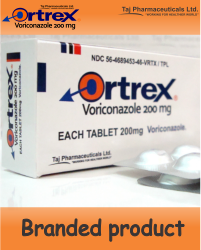FULL PRESCRIBING INFORMATION - ADVERSE REACTIONS

Ortrex Details
Contact Us
Taj Pharma India Brands
Taj Pharma Group (India)
214, Bake House, Bake House Lane,
Fort, Mumbai 400001, India.
E-mail: ortrex@tajpharma.com



ADVERSE REACTIONS
 Because clinical trials are conducted under widely varying conditions, adverse reaction rates observed in clinical trials of a drug cannot be directly compared to rates in the clinical trials of another drug and may not reflect the rates observed in practice.
Because clinical trials are conducted under widely varying conditions, adverse reaction rates observed in clinical trials of a drug cannot be directly compared to rates in the clinical trials of another drug and may not reflect the rates observed in practice.
Overview
The most frequently reported adverse events (all causalities) in the therapeutic trials were visual disturbances (18.7%), fever (5.7%), nausea (5.4%), rash (5.3%), vomiting (4.4%), chills (3.7%), headache (3.0%), liver function test increased (2.7%), tachycardia (2.4%), hallucinations (2.4%). The treatment-related adverse events which most often led to discontinuation of voriconazole therapy were elevated liver function tests, rash and visual disturbances [see Warning and Precautions ].
Clinical Trial Experience in Adults
Voriconazole in 1,655 patients in the therapeutic studies. This represents a heterogeneous population, including immunocompromised patients, e.g., patients with hematological malignancy or HIV and non-neutropenic patients. This subgroup does not include healthy subjects and patients treated in the compassionate use and non-therapeutic studies. This patient population was 62% male, had a mean age of 46 years (range 11 to 90, including 51 patients aged 12 to 18 years) and was 78% white and 10% black. Five hundred sixty one patients had a duration of voriconazole therapy of greater than 12 weeks, with 136 patients receiving voriconazole for over 6 months. Table 2 includes all adverse events which were reported at an incidence of ≥ 2% during voriconazole therapy in the all therapeutic studies population, studies 307/602 and 608 combined or study 305, as well as events of concern which occurred at an incidence of < 2%.
Visual Disturbances
Voriconazole treatment-related visual disturbances are common. In therapeutic trials, approximately 21% of patients experienced abnormal vision, color vision change and/or photophobia. Visual disturbances may be associated with higher plasma concentrations and/or doses.
There have been post-marketing reports of prolonged visual adverse events, including optic neuritis and papilledema
The mechanism of action of the visual disturbance is unknown, although the site of action is most likely to be within the retina. In a study in healthy subjects investigating the effect of 28-day treatment with voriconazole on retinal function, voriconazole caused a decrease in the electroretinogram (ERG) waveform amplitude, a decrease in the visual field and an alteration in color perception. The ERG measures electrical currents in the retina. The effects were noted early in administration of voriconazole and continued through the course of study drug dosing. Fourteen days after end of dosing, ERG, visual fields and color perception returned to normal
Dermatological Reactions
Dermatological reactions were common in the patients treated with voriconazole. The mechanism underlying these dermatologic adverse events remains unknown.
Serious cutaneous reactions, including Stevens-Johnson Syndrome, toxic epidermal necrolysis and erythema multiforme have been reported during treatment with voriconazole. If a patient develops an exfoliative cutaneous reaction, voriconazole should be discontinued.
In addition, voriconazole has been associated with photosensitivity skin reactions. Patients should avoid strong, direct sunlight during voriconazole therapy. In patients with photosensitivity skin reactions, squamous cell carcinoma of the skin and melanoma have been reported during long-term therapy. If a patient develops a skin lesion consistent with squamous cell carcinoma or melanoma, voriconazole should be discontinued
Less Common Adverse Events
Body as a Whole: abdominal pain, abdomen enlarged, allergic reaction, anaphylactoid reaction, ascites, asthenia, back pain, chest pain, cellulitis, edema, face edema, flank pain, flu syndrome, graft versus host reaction, granuloma, infection, bacterial infection, fungal infection, injection site pain, injection site infection/inflammation, mucous membrane disorder, multi-organ failure, pain, pelvic pain, peritonitis, sepsis, substernal chest pain
Clinical Laboratory Values
The overall incidence of clinically significant transaminase abnormalities in all therapeutic studies was 12.4% (206/1,655) of patients treated with voriconazole. Increased incidence of liver function test abnormalities may be associated with higher plasma concentrations and/or doses. The majority of abnormal liver function tests either resolved during treatment without dose adjustment or following dose adjustment, including discontinuation of therapy.
Voriconazole has been infrequently associated with cases of serious hepatic toxicity including cases of jaundice and rare cases of hepatitis and hepatic failure leading to death. Most of these patients had other serious underlying conditions.
Liver function tests should be evaluated at the start of and during the course of voriconazole therapy. Patients who develop abnormal liver function tests during voriconazole therapy should be monitored for the development of more severe hepatic injury. Patient management should include laboratory evaluation of hepatic function (particularly liver function tests and bilirubin). Discontinuation of voriconazole must be considered if clinical signs and symptoms consistent with liver disease develop that may be attributable to voriconazole
Acute renal failure has been observed in severely ill patients undergoing treatment with voriconazole. Patients being treated with voriconazole are likely to be treated concomitantly with nephrotoxic medications and have concurrent conditions that may result in decreased renal function. It is recommended that patients are monitored for the development of abnormal renal function. This should include laboratory evaluation, particularly serum creatinine.
Post-Marketing Experience
The following adverse reactions have been identified during post approval use of voriconazole. Because these reactions are reported voluntarily from a population of uncertain size, it is not always possible to reliably estimate their frequency or establish a causal relationship to drug exposure.
Skeletal
Fluorosis and periostitis have been reported during long-term voriconazole therapy
Download Ortrex Overview
Ortrex® Voriconazole 200mg tablets are a prescription medicine used to treat certain serious fungal infections in your blood and body. Ortrex® Voriconazole 200mg tablets sold by Taj Pharmaceuticals Limited (India), a global pharmaceuticals company. It is available in India, Middle East and a few other South Asian countries.
![]() Ortrex® Voriconazole 200mg tablets_CMI
Ortrex® Voriconazole 200mg tablets_CMI
![]() Ortrex® Voriconazole 200mg tablets_FPI
Ortrex® Voriconazole 200mg tablets_FPI


 Home
Home